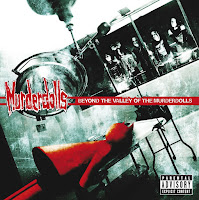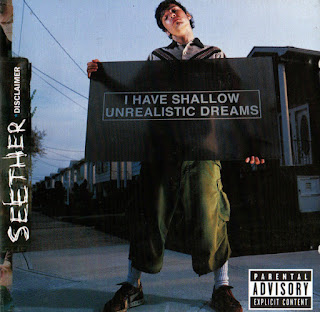V2.36
Your humble columnist has been known to ridicule the horrible marketing term “nu-metal,” both in these pages and elsewhere. There’s really not much “nu” about the tunes cranked out by bands like System of A Down, Slipknot, or Static X – it’s all a hybrid of punk and hard rock with a touch of hardcore, thrash and extreme metal thrown in for good measure. That being said, there are still some righteous jams being kicked out by some of the young bands making waves on the charts these days.
Slipknot is one of the most popular bands in the current nu-metal universe, the band building an enormously loyal following behind a pair of albums – 1999’s Slipknot and Iowa, from 2001. Both releases were huge multi-platinum hits, the Des Moines, Iowa band delivering hard-and-fast, uncompromising music the likes of which rock fans had never before heard. With an important slot in the 1999 Ozzfest tour, Slipknot celebrated Halloween every night on stage, adorned in matching industrial gray jumpsuits and individual scary masks.
Before they joined Slipknot in 1995, vocalist Corey Taylor and guitarist James Root had a band known as Stone Sour. During a break in Slipknot’s constant touring schedule, the pair got together with former bandmates and recorded their self-titled debut, Stone Sour (Roadrunner Records). Described as a “kinder, gentler” version of Slipknot, you would be hard pressed to convince anyone of this notion. The staccato machine-guitar riff that kicks off the album opening “Get Inside” slices as deep as anything you’ll find in the Slipknot milieu. Much of the disc straddles a stylistic fence, influences as disparate as Nirvana and Metallica informing Stone Sour’s sound.
Taylor is a reasonably flexible vocalist, capable of moving from a hard-rocking baritone to a blood-curdling scream within the space of a heartbeat, but it is Root’s chainsaw guitar that dominates the proceedings. Matching Taylor’s vocals beat for beat with great dexterity and a forcefulness that most guitarists can only dream of; Root blazes new trails for his metal brethren to follow. Taylor’s lyrics consist of typically obtuse molten poetry, decipherable only by enthusiastic teens, but apart from Slipknot’s rigid framework, he takes his vocals into new and impressive territory. With songs as muscular as “Cold Reader” or the 200-mph maniacal binge “Idle Hands,” who cares what the vocalist is throwing out – it’s the raw power that counts, and Stone Sour has it in abundance. Extra credit awarded for Taylor’s rant “Omega” that closes the disc, as inspired a bit of madness as you’re likely to hear from a chart-topping artist these days.
Stone Sour looks like any other gang of grunge-blasters hanging out on your typical USA street corner. Murderdolls, on the other hand, have a spooky, semi-Goth Marilyn Manson vibe going on with their appearance. The tunes on Beyond the Valley of the Murderdolls (Roadrunner Records) are sheer metal-tinged Glam rock, kind of like a revved-up and drunkenly manic Guns ‘N Roses. Featuring Joey Jordison from Slipknot and Tripp Eisen from Static X on six-string, Murderdolls is a deranged bunch of buggers, with song titles and subject matter unsuitable for a family paper.
The hype surrounding Murderdolls may say “nu-metal” but the sound is strictly Hollywood circa 1986, a highly-amped blend of punk, thrash and traditional metal thrown into a blender with the switch thrown on high. Vocalist Wednesday 13 sounds like he gargles with barbed wire and battery acid and the band’s twin guitars cut like a scalpel while the rhythm section stings like a nest of angry and very large hornets. Much of the material here is exaggerated and delivered tongue in cheek, kind of like the Misfits or Rob Zombie. Songs like “Dressed To Depress” or the cinematic dreams of “Dead In Hollywood” provide a potent lyrical and music elixir certain to cure your blues and peel the plaster from your walls.
Seether brings a South African perspective to the ever-fluid hard rock scene. Led by vocalist/songwriter Shaun Morgan, the band’s debut Disclaimer (Wind-Up Records) is an interesting blend of musical and lyrical influences, Morgan’s tales of alienation exhibiting Kurt Cobain-levels of angst and frustration. Musically, Seether treads closer to the Seattle sound of the early nineties than either of the two aforementioned bands, throwing in subtle instrumental flourishes that their flannel-clad ancestors never dreamed of. Morgan is a decent vocalist, with a deep voice that resonates with emotion and fluctuates between pain and pleasure much like Nirvana’s Cobain. He is still growing as a songwriter, but his material is still heads above much of what passes for intelligence in hard rock these days, and you have to love a guy who names his publishing company after an Alice Cooper song. Did I mention that Seether make a heck of a lot of noise for three guys? This is a band worth keeping an eye on...
For readers confused by this nu-metal stuff, music journalist Joel McIver has written a pretty good book on the subject. His Nu-Metal (Omnibus Books) calls itself “the essential reference book for 21st century metal fans” and for once, the hype isn’t far off the mark. McIver offers an informative look at the stylistic godfathers of nu-metal, bands like Faith No More, Nirvana and Jane’s Addiction that influenced a generation of artists to follow. He touches upon important scenemakers as well, folks like producer Ross Robinson and the Roadrunner Records label, but it is McIver’s “A – Z Guide,” presenting biographies of over a 100 bands, that makes the book work. McIver’s work is an invaluable guide to an every-growing and changing nu-metal music scene and a great sourcebook for rock fans. (View From The Hill, October 2002)




No comments:
Post a Comment